
Note: So that they better match the text, the numbers of some figures have been changed from the original.
Overall assessment: Attacks continue to be improbable or excessively simple. Meanwhile defenses continue to be unnecessarily complex. Also, assuming that the training program has limited time, and accepting as given that the first three defenses may not work against a taller or stronger opponent, why teach them at all?
The advice to turn the head into the choke is not mentioned until Section 35, and nowhere is it noted that whenever resisting chokes, one should always:

Reach up with your right hand, grasping the base of his thumb with your four fingers and the back of his hand with your right thumb, at the same time as you bend slightly to the right. (Figure 22-2.)

This movement will loosen his grip on your throat and make it a simple matter for you to remove his right hand. Immediately reinforce the right-hand grip with a similar grip with your left hand, crossing your thumbs on the back of his hand. By applying pressure on the back of the hand toward the opponent's wrist, your opponent will be forced to the ground. (Figure 22-3.) If this entire action is made swiftly, your opponent will find himself on the ground a split second after he grasps you by the throat. [Technical comment -- Defender should not be bent over as he is, otherwise he cannot make Attacker move -- the defense must come from the hips rather than the arms. Also, for Attacker to end up on the ground as described, Defender must enthusiastically push Attacker's trapped wrist (katate tori) at a 45 degree angle from his body; if pushed back straight, then Attacker merely reinforces his bent wrist with his other hand and pressures back. Finally, Defender's grip MUST control Attacker's thumb, as if Attacker can put his thumb against his little finger, then extrication from the lock becomes simple.]
28. SECOND DEFENSE AGAINST TWO-HAND FRONT CHOKE. -- Your opponent again grasps you around the throat from the front with both hands. This time, instead of throwing him, you wish to take him a prisoner. Your initial action is to reach under his left arm with your right forearm, placing your hand on top of his right hand. Your fingers grasp the palm of his right hand around the finger edge, and your thumb is on the back. (Figure 23-1.)

Now turn to your right, pulling your opponent's right hand away from your throat and turning your hand in the same direction as you are turning your body. This will cause him to turn his back to you. Now reinforce your original grip on his right hand with a similar grip with your left hand. Your defense will terminate as illustrated in figure 23-2.
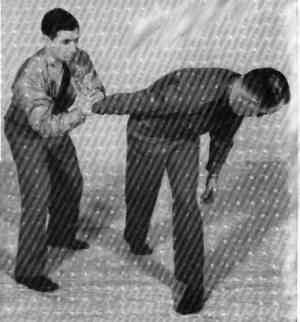
In this position, he is your prisoner and can be moved where you will by applying pressure toward his wrist. [Technical comments -- The wrist twist described assumes roughly equal strength on the part of Attacker and Defender; if Attacker is noticeably stronger or not using much thumb strength, the rotation simply will not work. A better starting technique is therefore for Defender to start the motion by first kicking Attacker in the shin on the side that he hopes to turn. The ending position is ludicrous, as essentially all that Attacker needs to do to escape the lock is step forward with his right foot while simultaneously straightening his back.]
29. THIRD DEFENSE AGAINST TWO-HAND FRONT CHOKE. -- Your opponent again grasps you around the throat from the front with two hands. Your defense this time will be such as to bring your opponent into a position where you can march him at a great distance without losing control. Your right arm this time goes over his left arm and under his right one, the back of your hand resting underneath his right wrist. Your right hand forms a cup into which your fist will rest. (Figure 24-1.)

Strike upward with your left fist against your cupped right hand, thus breaking your opponent's right-hand grip on your throat and simultaneously loosening his left hand. As soon as the hold is broken, your right hand turns, grasping your opponent's right wrist with your thumb toward his body. (Figure 24-2.)
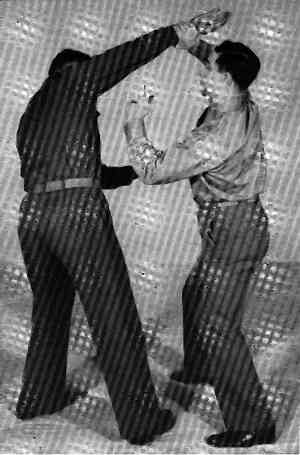
Now place your left hand behind your opponent's right elbow without actually grasping it and push with your left arm and pull with your right hand, causing your opponent to pivot, at the same time bending his right arm. (Figure 24-3.)
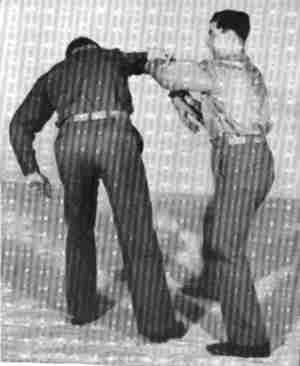
You now have sufficient control of his right wrist to bend his arm at the elbow, bringing his right hand into the crook of your left elbow and slipping your left hand up to his arm to a point near the shoulder which you can then grasp, terminating in the position illustrated in Figure 24-4.

However, this procedure is not recommended except when meeting resistance. This is simply a means of marching a man where you wish him to go, utilizing but one arm and leaving the other free for any necessary action. [Technical comments -- Reaching over as described in Figure 24-1 is slow, and does nothing to prevent Attacker from simply letting go and kicking Defender in the groin. In Figure 24-3, Defender should knee Attacker in the thigh to assure compliance, otherwise Attacker will simply stand up and escape. In Figure 24-4, the armlock is easily escaped because Defender does not control Attacker's center or head. So Attacker simply steps across with the left foot, pivots smartly from the hips, and does his best to cold-cock Defender with a left hook to the jaw. Defender also needs to stand closer at all times to have any hope of making this technique work.]
30. DEFENSE AGAINST TWO-HAND FRONT CHOKE BY A TALL MAN. -- This will describe the proper defense when you are being choked by a very tall man, against whom some of the previous defenses might not work. Step forward with your right foot, crossing your right foot, crossing your right arm with some force over both your opponent's arms, with the palm of your hand to the ground (Figure 25-1.)

By turning your body to the right, using the power of your midsection and shoulders, you will bring the little finger edge of your hand (not the little finger itself) against the right side of your opponent's neck just below the jawbone. (Figure 25-2.) This is a knockout blow.
[Technical comments -- In Figure 25-1, Defender gets better leverage if he keeps his spine erect rather than bending away from the attack. The leverage is good, however. In Figure 25-2, Defender's left hand should attack Attacker's right wrist, in hopes of getting a wrist trap, while his right foot should bash Attacker's right ankle (ko-uchi gari). Overall, this is the first practical defense shown.]
31. DEFENSE AGAINST TWO-HAND FRONT CHOKE BY A SHORT MAN. -- You reach forward and inside your opponent's arms, grasping either his hair, or if he is bald, grasping his ears. (Figure 26-1.)

You then pull downward on either hair or ears at the same time raising your knee. This will bring your opponent's face downward with great force as your knee travels upward with an equal amount of power, meeting somewhere in between. (Figure 26-2.)
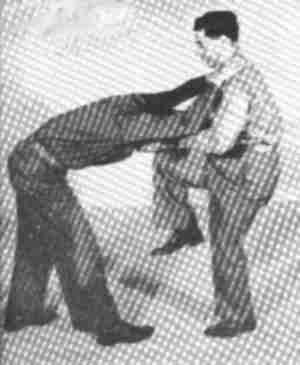
Since these two objects are approaching each other, the force is multiplied. Since your knee or thigh is definitely more capable of taking punishment than your opponent's face, the results are plainly evident. [Technical comments: How sweet it is.]
32. FIRST DEFENSE AGAINST TWO-HAND FRONT CHOKE AGAINST THE WALL. -- Ordinarily an individual who attempts to choke you in this fashion extends his arms, squeezes with the fingers, and pushes you against the wall. (Figure 27-1.)

Your immediate action is to bring the heel of your hands, one on either side of his elbows, applying pressure inward (toward each other) and away from you. (Figure 27-2.) The reaction is such as to prevent your opponent from using the power of his fingers, and he will find that he cannot choke you, try as he will. [Technical comment -- Attacker needs merely drop his elbows and step in to resume his choke. The defense shown does not prevent Attacker from doing the sensible thing, either, namely kneeing Defender in the groin, which is another way of prefacing his renewed choke.]
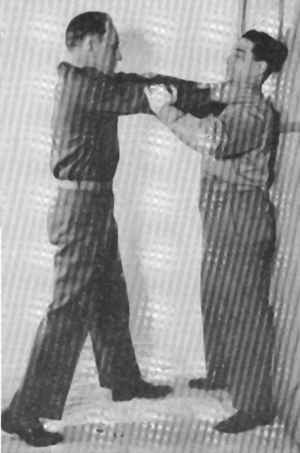
33. SECOND DEFENSE AGAINST TWO-HAND FRONT CHOKE AGAINST THE WALL. -- You reach under your opponent's right arm and over his left one, placing your fingers on the outside of his left elbow. You also place the palm of your right hand over the same elbow if necessary, over your own fingers. (Figure 28-1.)
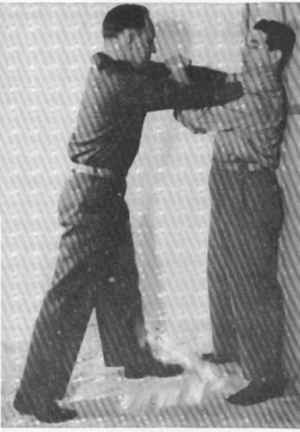
By applying sharp pressure from the body on this elbow, you will force your opponent to your left, and in most cases, crash his head against the wall. (Figure 28-2.)
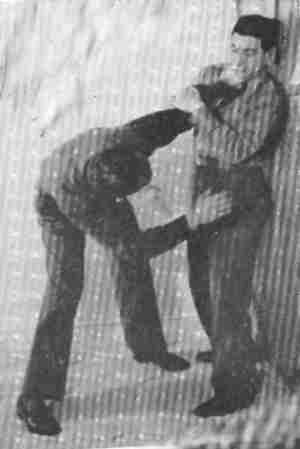
[Technical comments -- Defender should preface the grasp with a kick to Attacker's shins, otherwise Attacker's center is unbroken and nothing will happen. In Figure 2-2, Defender should try the simpler and equally effective knee to face.]
34. THIRD DEFENSE AGAINST TWO-HAND FRONT CHOKE AGAINST THE WALL. -- If your opponent should grasp you in this manner and bend his arms, he will thus render the first two defenses useless. Your defense for such an attack will be to raise your left hand, the back of your hand toward the ground, and strike with the power of the body between hip bone and the floating ribs. Contact is made with the little finger edge of the hand. [Figure 29.]

This blow can be delivered by either hand on either side, depending on whether you are right-handed or left-handed. It will cause your opponent to release his hold, and, in most cases, also deprive him of his wind for a good space of time. [Technical comment -- This is the first realistic choke shown, and it is probable that in practice Attacker would stand even closer, with his knee between Defender's legs. Defender in this case should place the index finger of one hand in the notch in Attacker's collarbone prior to striking with the other hand.]
35. DEFENSE AGAINST ONE-ARM STRANGLE FROM REAR. -- Your opponent attacks as illustrated in Figure 30-1.
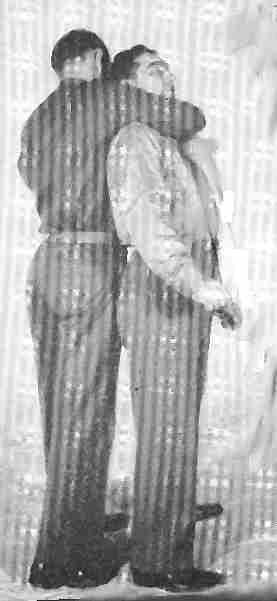
Your initial reaction is to place your chin in the crook of your opponent's elbow so that he cannot choke you, at the same time grasping the back of his arm just above the elbow with your right hand and placing your right foot just on the outside of his right foot. (Figure 30-2.)
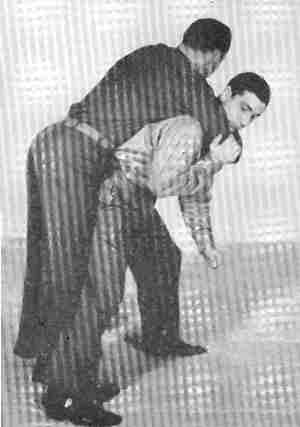
By striking backwards with your hips against his midsection, retaining your hold on his upper arm with your right hand and bending from the waist swiftly, you will catapult your opponent over your head and to the ground. (Figure 30-3.)
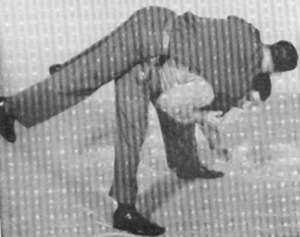
[Technical comments -- The choke is weak, and to resist being thrown Attacker should have most of his weight on his back foot (neko ashi dachi). Meanwhile, to keep Attacker from letting go once he realizes the throw is coming, Defender needs to put both his hands on Attacker's arms while keeping spine erect but bending the knees. The rotation then comes from the hip, with Defender's right arm (in this case) providing considerable pull.]
36. DEFENSE AGAINST TWO-HAND CHOKE FROM REAR. -- Your opponent attacks in the manner illustrated in Figure 31-1.
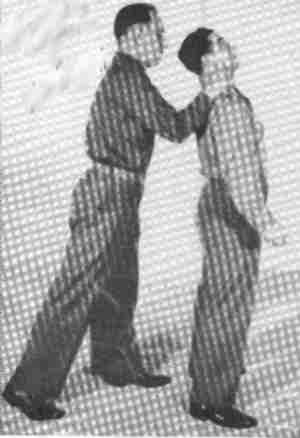
Your initial action is to reach up with your right hand, grasping the base of his right thumb and placing your own right thumb on the back of his hand close to the wrist, at the same time bending to the right. (Figure 31-2.)

You now balance on your right foot, pivoting on the sole of that foot to the right, using your left leg for momentum. As soon as you have executed half a right turn, you will reinforce your grip on your opponent's right hand with a grip with your left hand, twisting strongly to your left. (Figure 31-3.)
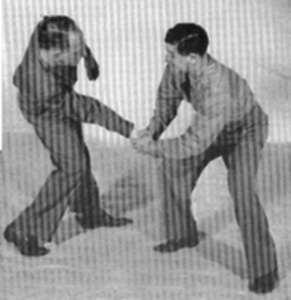
This will result in your opponent either executing a somersault, usually landing on his head, or having his wrist dislocated and broken. [Technical comment -- As illustrated in the pictures, this last sentence is hyperbolic, as Attacker merely needs to take the weight off his right leg to escape. (There are many ways this could be done, and Defender's stance is so bad that he could not prevent the escape.) However, if Defender had a better stance, with spine erect, he could forestall that and get a takedown (tekubi tori A), most likely by stepping forward with his right foot at a 45-degree angle to Attacker's head.]
37. DEFENSE AGAINST ONE-HAND FRONT CHOKE. -- Your opponent attacks by grasping you by the throat with his right hand and attempting to choke you as illustrated in Figure 32-1.
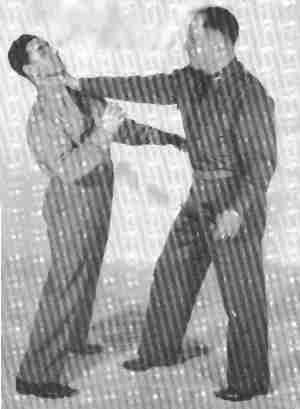
You step backward with your right foot, at the same time grasping his right wrist and holding it close to your throat. Place your left foot between and in front of his legs. (Figure 32-2.)
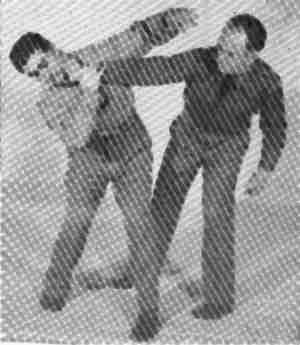
Bring your left arm over your opponent's right elbow without touching it with your hand; retaining your grasp on your opponent's right wrist with your right hand, you bring your armpit on top of his right elbow, and turning to the right, reinforce the grasp on his wrist with a similar grasp with your left hand. Now bring pressure to bear by lifting upward on the captured right wrist and pushing downward with your armpit on his elbow. In this position, you can either force him to submit, or to suffer a broken or dislocated elbow.
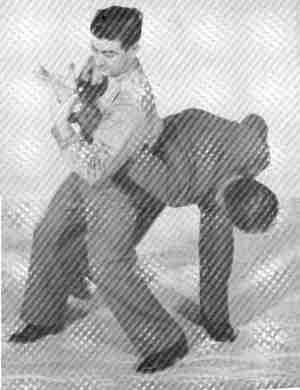
[Technical comments -- Attacker's grasp would be stronger if he were to use his left hand simultaneously to hold Defender's belt. Defender, in Figure 32-2, should try to stay erect rather than bending so much. The lock shown in Figure 32-3 is ude garame.]
About the Technical Commentators
Mike Belzer began practicing Kodenkan (Danzan Ryu) jujutsu at age 9, and in 1974, at age 18, he met and trained with Donn F. Draeger and Takaji Shimizu in Japan. In 1979, after returning to the US from a trip to Malaysia with Draeger, he also began studying Filipino kali under Dan Inosanto. Since 1990 he has focused his training on using "adrenal-stress conditioning" in realistic scenarios against heavily padded assailants. He is presently ranked 5-dan in Kodenkan jujutsu and apprentice instructor in kali, and serves as a consultant to the Los Angeles Police Department's Civilian Martial Arts Advisory Panel (CMAAP).
Joseph Svinth is editor of Journal of Non-lethal Combatives.